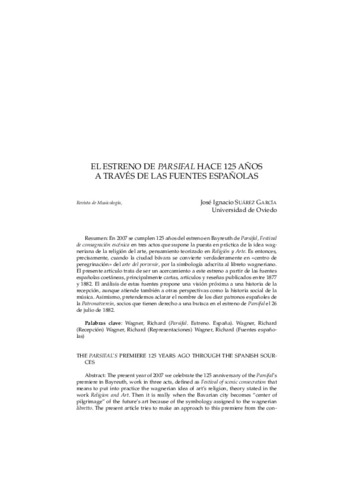El estreno de "Parsifal" hace 125 años a través de las fuentes españolas
Autor(es) y otros:
Fecha de publicación:
Editorial:
Sociedad Española de Musicología (SEdeM)
Citación:
Descripción física:
Resumen:
En 2007 se cumplen 125 años del estreno en Bayreuth de Parsifal, Festival de consagración escénica en tres actos que supone la puesta en práctica de la idea wagneriana de la religión del arte, pensamiento teorizado en Religión y Arte. Es entonces, precisamente, cuando la ciudad bávara se convierte verdaderamente en «centro de peregrinación» del arte del porvenir, por la simbología adscrita al libreto wagneriano. El presente artículo trata de ser un acercamiento a este estreno a partir de las fuentes españolas coetáneas, principalmente cartas, artículos y reseñas publicados entre 1877 y 1882. El análisis de estas fuentes propone una visión próxima a una historia de la recepción, aunque atiende también a otras perspectivas como la historia social de la música. Asimismo, pretendemos aclarar el nombre de los diez patronos españoles de la Patronatverein, socios que tienen derecho a una butaca en el estreno de Parsifal el 26 de julio de 1882.-- Abstract: The present year of 2007 we celebrate the 125 anniversary of the Parsifal’s premiere in Bayreuth, work in three acts, defined as Festival of scenic consecration that means to put into practice the wagnerian idea of art’s religion, theory stated in the work Religion and Art. Then it is really when the Bavarian city becomes “center of pilgrimage” of the future’s art because of the symbology assigned to the wagnerian libretto. The present article tries to make an approach to this premiere from the contemporary Spanish sources, mainly letters, articles and reviews published between 1877 and 1882. The analysis of these sources proposes a view close to a history of the reception, although it also takes care of other perspectives like the social history of music. Also, we try to explain the name of the ten Spanish sponsors of the Patronatverein, partners who have right to seat in the stalls in the Parsifal’s premiere the 26 of July of 1882.
En 2007 se cumplen 125 años del estreno en Bayreuth de Parsifal, Festival de consagración escénica en tres actos que supone la puesta en práctica de la idea wagneriana de la religión del arte, pensamiento teorizado en Religión y Arte. Es entonces, precisamente, cuando la ciudad bávara se convierte verdaderamente en «centro de peregrinación» del arte del porvenir, por la simbología adscrita al libreto wagneriano. El presente artículo trata de ser un acercamiento a este estreno a partir de las fuentes españolas coetáneas, principalmente cartas, artículos y reseñas publicados entre 1877 y 1882. El análisis de estas fuentes propone una visión próxima a una historia de la recepción, aunque atiende también a otras perspectivas como la historia social de la música. Asimismo, pretendemos aclarar el nombre de los diez patronos españoles de la Patronatverein, socios que tienen derecho a una butaca en el estreno de Parsifal el 26 de julio de 1882.-- Abstract: The present year of 2007 we celebrate the 125 anniversary of the Parsifal’s premiere in Bayreuth, work in three acts, defined as Festival of scenic consecration that means to put into practice the wagnerian idea of art’s religion, theory stated in the work Religion and Art. Then it is really when the Bavarian city becomes “center of pilgrimage” of the future’s art because of the symbology assigned to the wagnerian libretto. The present article tries to make an approach to this premiere from the contemporary Spanish sources, mainly letters, articles and reviews published between 1877 and 1882. The analysis of these sources proposes a view close to a history of the reception, although it also takes care of other perspectives like the social history of music. Also, we try to explain the name of the ten Spanish sponsors of the Patronatverein, partners who have right to seat in the stalls in the Parsifal’s premiere the 26 of July of 1882.
ISSN:
Colecciones
- Artículos [37548]
- Historia del Arte y Musicología [500]
Ficheros en el ítem




